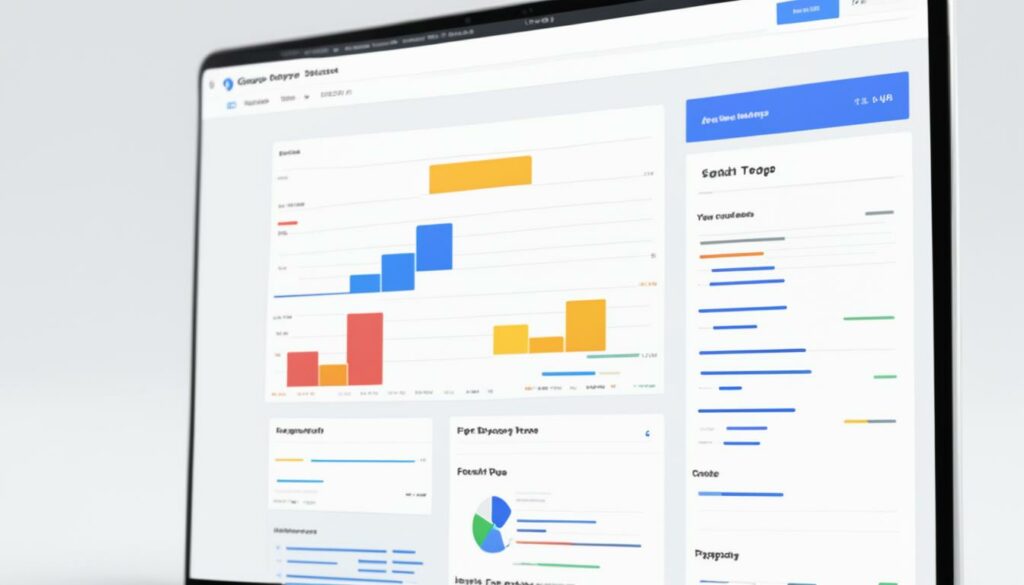Have you ever dreamed of running your own business and reaching customers around the world? With the growing popularity of online shopping, now is the perfect time to start an online shop and turn your entrepreneurial vision into a reality. But where do you begin?
In this comprehensive guide, we will walk you through the process of creating a successful online store step-by-step. Whether you’re a small business owner looking to expand your reach or an aspiring entrepreneur eager to enter the e-commerce world, this guide is packed with valuable insights and practical tips to help you build a web store that stands out and drives sales.
From choosing your target audience to launching your online store, we’ll cover it all. So, let’s dive in and discover the secrets to building a thriving e-commerce website that fuels your business growth.
Key Takeaways:
- Starting an online store is a rewarding and profitable venture that requires the right tools and guidance.
- Understanding your target audience is crucial for attracting interested buyers to your website.
- Choosing the right products that align with your business idea is essential for success.
- Selecting an ecommerce platform with user-friendly features and customer support is vital.
- Designing your brand and optimizing your website are key steps in launching a successful online store.
Decide on a Target Audience
In order to create a successful online store, you need to have a clear understanding of your target audience. Identifying their demographics, such as age, gender, occupation, education, and income, is crucial. But it doesn’t stop there. It’s also important to consider their location, interests, attitudes, personality, opinions, and lifestyle. By exploring these aspects, you can build a solid buyer persona and tailor your marketing efforts to attract interested buyers to your website.
Knowing your target audience is like having a secret weapon in the e-commerce world. It not only guides your marketing strategies but also helps you create personalized experiences that resonate with your customers.
By dividing the market based on geographic location, you can better serve a specific area and meet the unique needs of local shoppers. For example, if you sell surfboards, targeting coastal regions with popular surfing spots would be a smart move.
Understanding the interests of your target audience is essential when it comes to product selection and marketing. By knowing what your potential customers are passionate about, you can curate a product range that appeals to their specific needs and desires. Whether it’s eco-friendly fashion, gourmet cooking supplies, or vintage collectibles, align your products with your audience’s interests to maximize sales.
Building a Buyer Persona
Building a buyer persona is a valuable exercise that involves creating a fictional representation of your ideal customer. This persona should encompass all the characteristics and traits that define your target audience. Here’s an example of what a buyer persona might look like for an online store selling athletic gear:
| Demographics | Location | Interests |
|---|---|---|
| Age: 25-34 | Urban areas in the United States | Fitness, outdoor activities, sports |
| Gender: Male & Female | Specifically targeting major cities | Triathlons, hiking, cycling |
| Occupation: Young professionals | Access to parks, trails, and gyms | Running, swimming, yoga |
| Education: College graduates | Places with a fitness-oriented culture | Fitness apparel, equipment, nutrition supplements |
| Income: $50,000 – $100,000 per year |
By visualizing your target audience through a buyer persona, you can better understand their needs, tailor your messaging, design a user-friendly website, and create targeted marketing campaigns.
Find a Business Idea and Choose Your Products
Finding a profitable business idea and choosing the right products to sell are crucial steps in building an online store. To ensure success, it’s important to align your business idea with your passions and interests. By focusing on something you love, you’ll be more motivated and better equipped to meet the needs of your target audience.
Consider these strategies to find a business idea that meets your goals:
- Identify your passions: Reflect on your hobbies, interests, and skills to find business ideas that truly excite you. This will make your entrepreneurial journey more enjoyable and fulfilling.
- Appeal to hobbyists: Explore niche markets and target audiences that have passionate hobbyists. These dedicated enthusiasts often invest significant time and money into their hobbies, making them ideal customers for your online store.
- Capitalize on trends: Stay updated on current trends and market demands. Look for emerging trends or popular products that have the potential to generate high demand and profitability. By capitalizing on trends, you can capture the interest of a wider audience and drive sales.
When choosing your products, it’s essential to conduct thorough market research to ensure they have the potential for profitability. Consider these factors:
- Demand: Identify products that are in high demand and align with the interests of your target audience. This will increase the likelihood of generating consistent sales.
- Profitability: Evaluate the potential profit margins of the products you plan to sell. Consider factors such as manufacturing costs, competition, and market demand to ensure you can achieve sustainable profitability.
- Product sourcing strategies: Determine the most suitable product sourcing strategy for your online store. This may involve manufacturing your own products, reselling established brands, or utilizing dropshipping services. Each strategy has its own advantages and considerations, so choose the one that aligns with your business goals.
By carefully selecting a business idea and choosing profitable products that appeal to hobbyists or capitalize on trends, you’ll be able to create a compelling online store that resonates with your target audience.
Next, let’s move on to Section 4 to learn about choosing the right ecommerce platform for your online store.
Choose an Ecommerce Platform
When building an online store, one of the most crucial decisions you’ll make is choosing the right ecommerce platform. Your chosen platform will determine the usability of your website, the level of customer support you receive, the ease of a friction-free checkout process, and even the web hosting services you’ll use. To ensure you make the best choice for your online store, consider the following factors:
Usability
A user-friendly ecommerce platform is essential for both you and your customers. Look for platforms that offer an intuitive drag-and-drop website builder, allowing you to easily customize and design your store without needing coding expertise. The simpler it is to navigate and operate your online store, the more time and energy you can dedicate to growing your business.
Customer Support
Having accessible and reliable customer support is crucial for any ecommerce platform. You’ll want prompt assistance whenever you encounter technical difficulties or have questions about the platform’s features. Look for platforms that offer various support channels like live chat, email, or phone support, ensuring you have the necessary assistance to resolve any issues that may arise.
A Friction-Free Checkout Process
Your ecommerce platform should provide a seamless and friction-free checkout process for your customers. Long and complicated checkout processes can lead to cart abandonment and lost sales. Look for platforms that offer features such as guest checkout, one-click payments, and multiple payment options to provide a smooth and convenient experience for your customers.
Web Hosting
Consider whether the ecommerce platform provides web hosting services or if you need to use a separate web hosting provider. If the platform offers web hosting, ensure that it provides reliable and secure hosting, as a slow or unreliable website can negatively impact user experience and ultimately harm your business. If you need to use a separate web hosting provider, make sure it is compatible with your chosen ecommerce platform and offers the necessary resources to support your online store.
By carefully evaluating these factors, you’ll be able to choose an ecommerce platform that meets your specific needs and sets you up for success in building and running your online store.
| Factors to Consider | Potential Platforms |
|---|---|
| Usability | Shopify, Wix, Squarespace |
| Customer Support | BigCommerce, Magento, WooCommerce |
| Friction-Free Checkout | Shopify, WooCommerce, BigCommerce |
| Web Hosting | Shopify, BigCommerce, Wix |

Design Your Brand and Launch Your Online Store
Now that you have chosen your target audience, business idea, and ecommerce platform, it’s time to take the next step: design your brand and launch your online store. This is your opportunity to create a distinct identity that will resonate with your target audience and set your store apart from the competition.
Start by establishing your brand values, mission, and unique selling proposition. What do you stand for? What sets your store apart? Clearly define your brand’s personality and values to connect with your audience on a deeper level.
Incorporate these elements into your brand design, starting with a memorable logo. Your logo should be visually appealing and representative of your brand’s identity. Use consistent visual elements throughout your website and marketing materials to create a cohesive and professional look.
When designing your website, ensure that it reflects your brand’s image and values. Use colors, fonts, and imagery that align with your brand identity. Optimize your site for search engines by using relevant keywords in your website content and meta tags. This will help potential customers find your store when they search for products you offer.
Don’t forget about marketing! Implement effective marketing strategies to promote your online store and attract customers. Utilize social media, email marketing, and search engine advertising to reach your target audience. Consider crafting engaging product descriptions and enticing product photos to showcase the unique features and benefits of your products.
When everything is in place, it’s time to launch your online store and start selling your products to the world. Stay consistent with your branding and continue to optimize your site and marketing efforts as your business grows. With a strong brand and effective marketing, your online store can thrive in the competitive e-commerce landscape.
FAQ
Q: How do I choose a target audience for my online store?
A: To choose a target audience, consider their demographics such as age, gender, occupation, education, and income. Also, think about their location and their interests, attitudes, personality, opinions, and lifestyle. This will help you create a buyer persona and guide your marketing efforts.
Q: How do I find a profitable business idea and select the right products to sell?
A: Start by brainstorming business ideas based on your passions and interests. Look for opportunities to appeal to enthusiastic hobbyists or capitalize on emerging trends. Conduct market research to identify products that are in demand and have the potential for profitability. Decide on the right product sourcing strategy, such as manufacturing, reselling, or dropshipping, to find the best products for your online store.
Q: What factors should I consider when choosing an ecommerce platform?
A: When selecting an ecommerce platform, consider factors such as usability, customer support, and a friction-free checkout process. Look for a platform with an intuitive drag-and-drop online store builder and accessible customer support. Also, consider if the platform provides web hosting services or if you need to use a third-party solution. Take into account your current and future needs to choose the best ecommerce platform for your online store.
Q: How can I design my brand and launch my online store?
A: Start by establishing your brand values, mission, and unique selling proposition. Create a brand identity that resonates with your target audience by designing a memorable logo and consistent visual elements. Design your website to reflect your brand and optimize it for search engines. Implement effective marketing strategies to promote your online store and attract customers. Finally, launch your online store and start selling your products to the world.












